文章目录
前言
最近心情非常郁闷,搓一个CS144玩玩吧,正好2023 spring出新版了。。。CS144的头4个Lab(加上0是5个),一步步实现了一个TCP。在开始之前,我想贴一下Lab中的这句话:The lab documents aren’t “specifications”—meaning they’re not intended to be consumed in a one-way fashion. They’re written closer to the level of detail that a software
engineer will get from a boss or client.
这句话是说这个Lab的文档并不那么标准化,它看起来更像你的leader给你的需求文档,这话什么意思呢,这里我就不解释了,相信大家跟着这个Lab从头到尾做一遍就会有体会了(笑
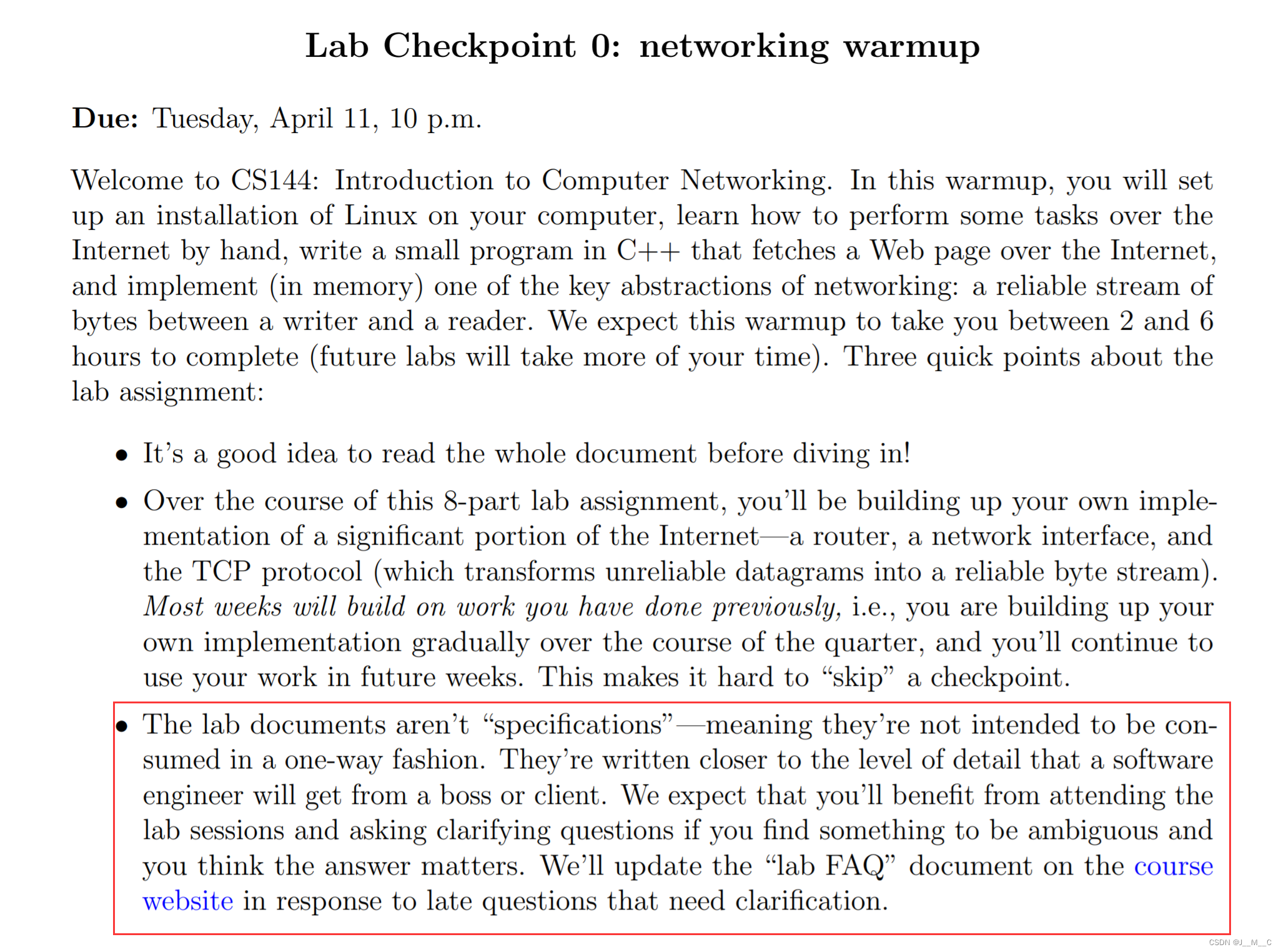
其他笔记
Lab 0: networking warmup
Lab 1: stitching substrings into a byte stream
相关链接
1. Set up GNU/Linux on your computer

官方推荐环境有vbox镜像、谷歌云,以及原生Ubuntu安装,我本来想下他那个镜像的就懒得配了,结果一看3G大,挂上魔法都只有100kb的龟速。。。还是用我的WSL吧,Ubuntu版本要求22.10,g++要求12.2
命令行运行它这一串就行了
sudo apt update && sudo apt install git cmake gdb build-essential clang \
clang-tidy clang-format gcc-doc pkg-config glibc-doc tcpdump tshark
这里点是
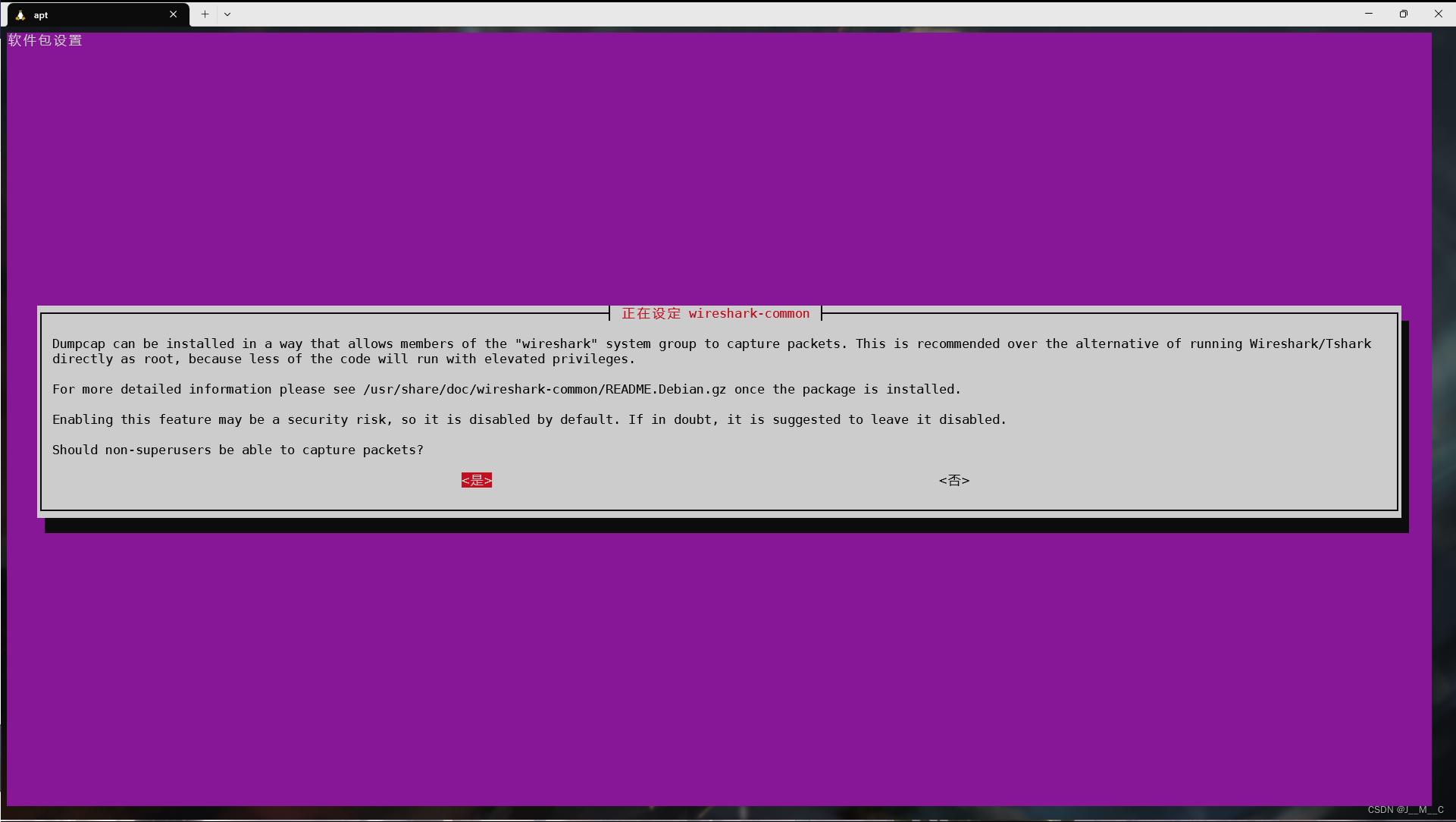
安装速度比下载镜像不知道高到哪里去了(21min是因为我挂着等截图,实际估计一两分钟)(

由于lab要求使用gcc12,而Ubuntu20的官方源没有gcc12,我选择将Ubuntu20直接更新到22,但是强烈不推荐,因为众所周知的原因,我在更新系统的途中耗时极多。。如图,花了得有几个小时。。建议去微软商店里面直接下载新的22。
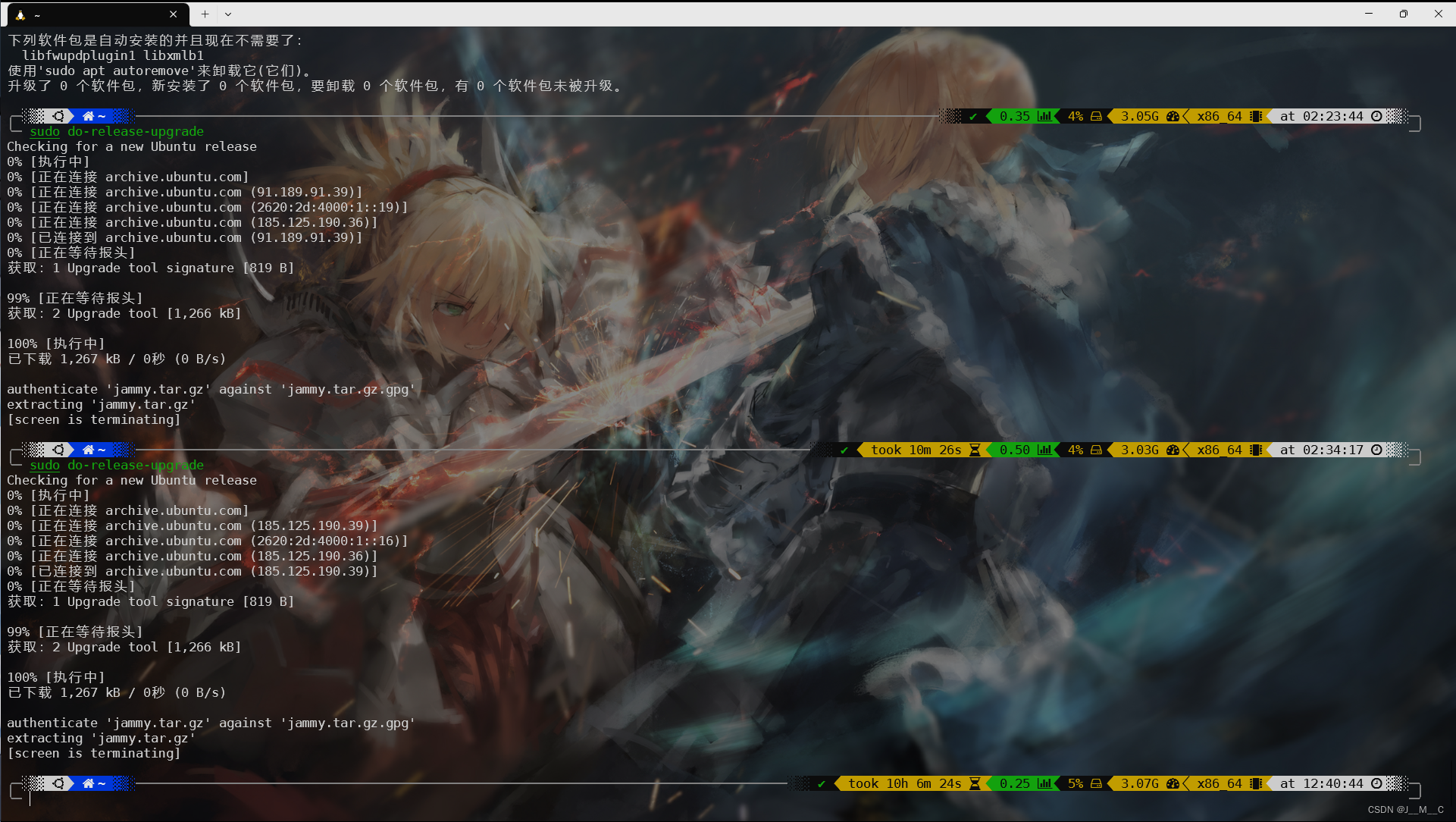
安装好gcc12后,可以如图指定gcc各版本优先级以指定默认版本。
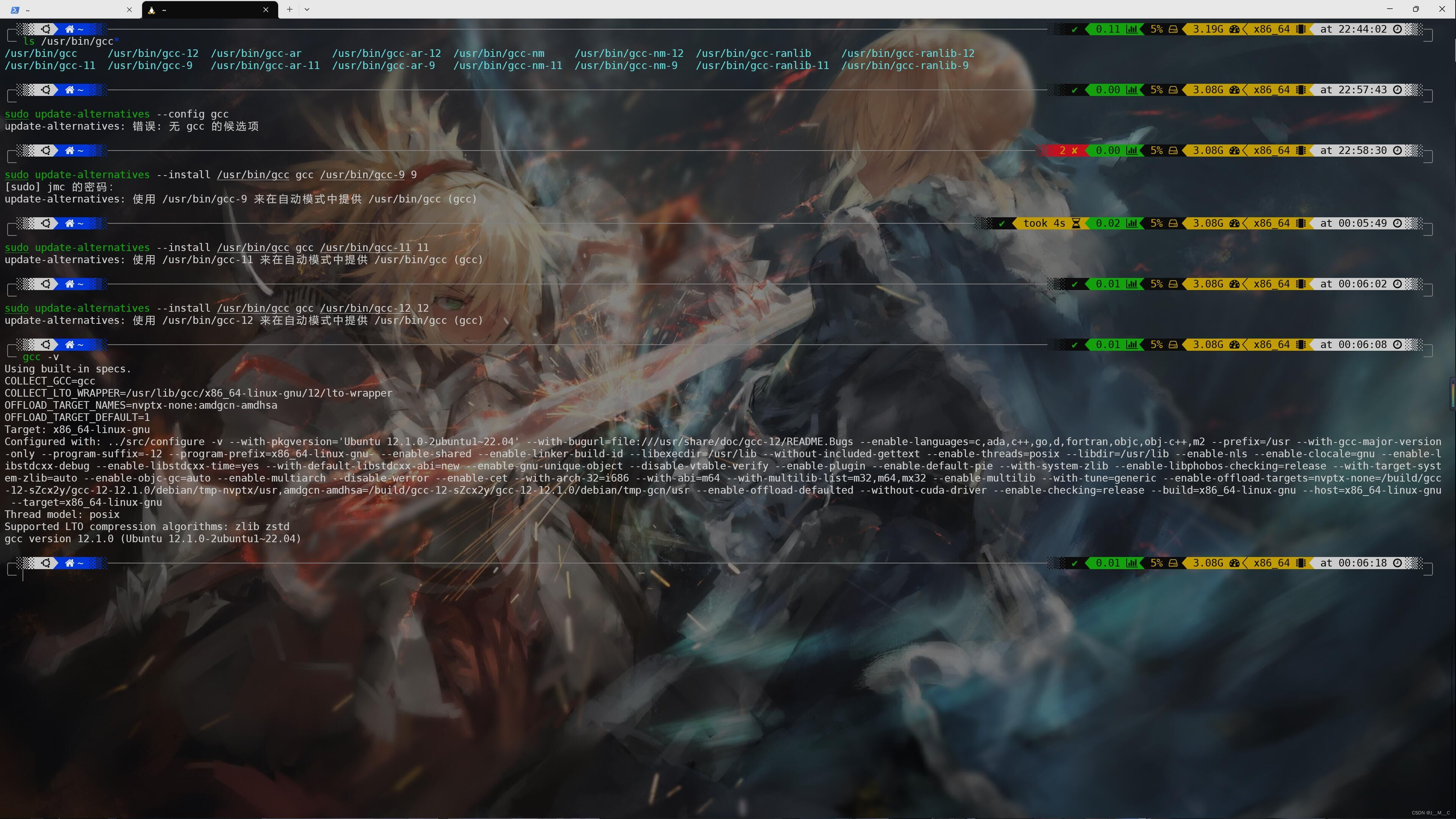
2. Networking by hand
这一节主要是叫你手动搭建网络感受一下里面的过程,头俩没啥好说的,2.3 Listening and connecting的比较有意思,是叫搭建一个双工通信:
首先我们在终端里跑一下netcat -v -l -p 9090:

然后新开一个终端,在里面运行telnet localhost 9090:

可以看到它建立了连接,这个时候我们回到刚才的终端,发现更新了:

我们随便输入一点东西,并切到隔壁去,会发现隔壁也能收到并显示:


这个操作在两边都能完成,可以看出我们建立了双工通信。
3. Writing a network program using an OS stream socket
Task3是叫用socket简单写一个网络编程。值得一提的是,Lab鼓励我们用上Modern C++,从代码上来看,Lab自己至少使用了C++20的内容,而我也会尽可能展示C++20乃至C++23的实现()

3.1 Linux配置
这一步我们先在linux里拉取仓库代码后编译,不过这个项目要求cmake 3.24.2以上 = =,我的是3.22.1,汗。。。又要更新,我直接更新到了3.27.0。

跟着流程走一遍编译:
git clone https://github.com/cs144/minnow
cd minnow
cmake -S . -B build
cmake --build build
发现报了俩错
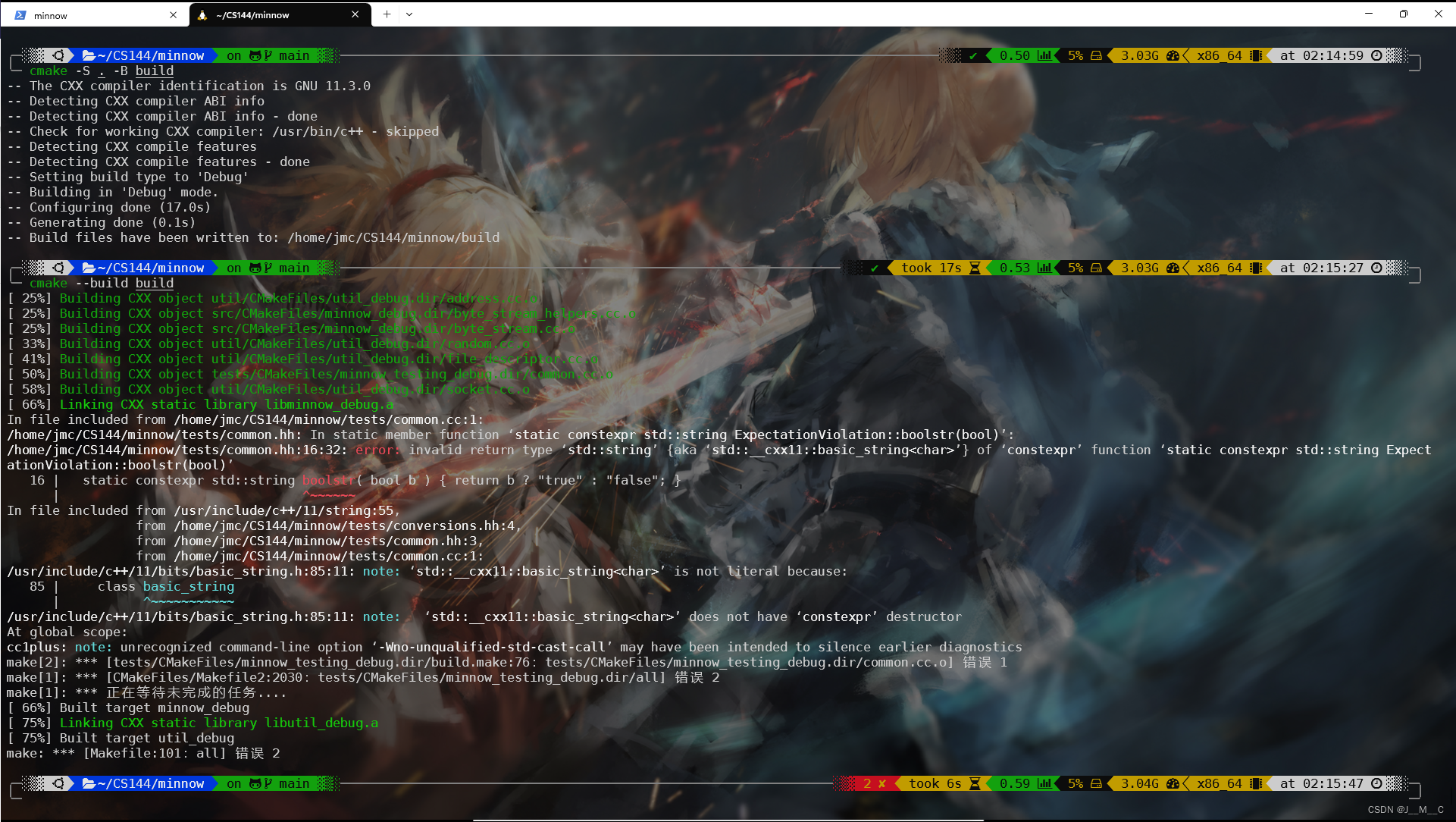
把报错贴出来方便后来人搜索:
error: invalid return type ‘std::string’ {aka ‘std::__cxx11::basic_string’} of ‘constexpr’ function ‘static constexpr std::string ExpectationViolation::boolstr(bool)’
16 | static constexpr std::string boolstr( bool b ) { return b ? “true” : “false”; }
| ^~~~~~~
看一下报错说的是string不为constexpr类型,我记得constexpr string好像是C++20的内容,这里用的C++11,明显是编译器环境没整对,一查g++ -v,发现果然之前搞了gcc的默认忘改g++了,同样的操作软链接一下:
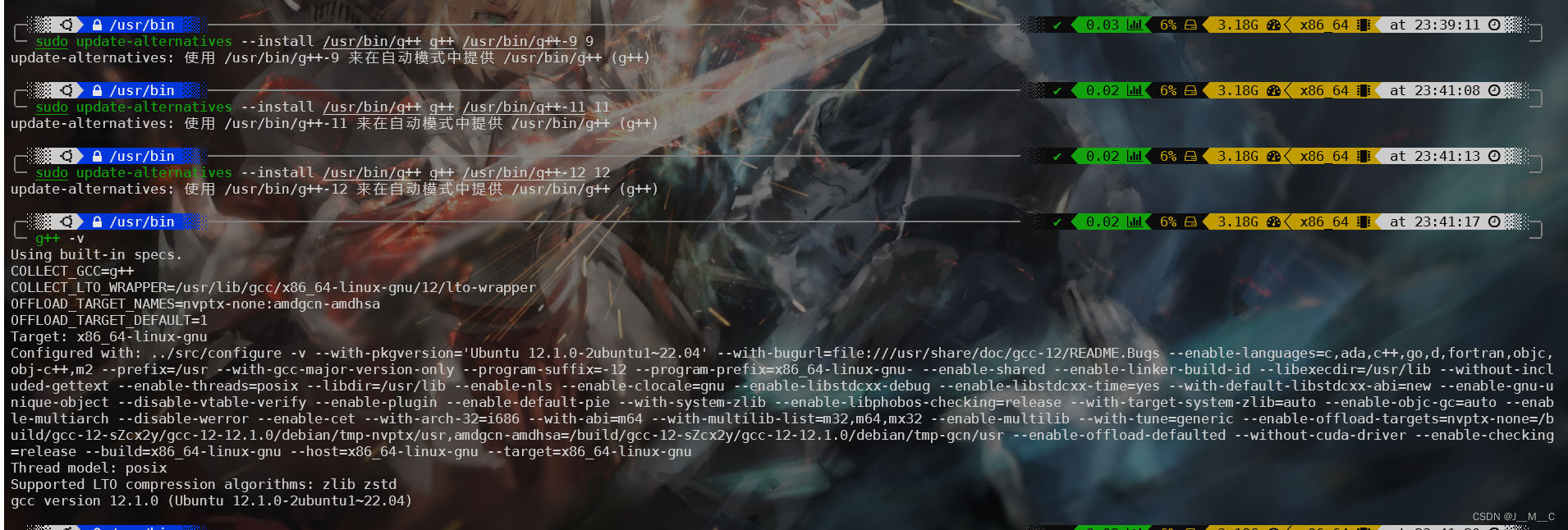
再跑一下编译,很成功:

然后我们还是把他推到我们现有的库里
git remote rm origin # 删除当前远程库
git remote add origin + 远程仓库地址 # 连接到现有的自己的库
git branch -M main
git push -u origin main
然后在vs里导入这个仓库,不演示了。拿到手上先把构建项目的文件给加进gitignore里面:
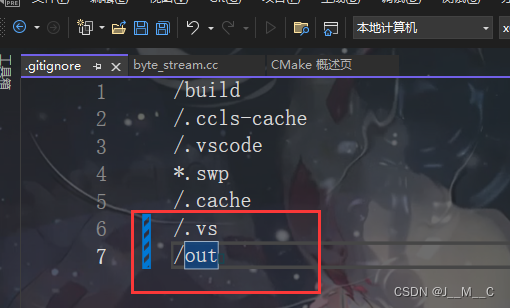
我的工具链一般是VS上编辑完后,git到远程,然后wsl上拉取后编译运行。如果需要调试,就直接在VS上打断点在VS上运行调试,这个Lab有CMake,方便得多。
3.2 C++规范

在开始之前,我们来看一下他提到的一些规范要求:
- 禁用动态内存分配(malloc&free、new&delete)
- 禁用裸指针、如果要用指针就用智能指针,不过看提示说CS144不太用得到指针
- 避免模板、线程、锁、虚函数,说CS144用不到这些
- 避免使用C风格字符串和C的那一套str-函数,用
std::string代替 - 避免使用C风格cast,用
static_cast代替,不过CS144一般用不到 - 尽量使用
const引用传参 - 函数和变量能用
const修饰则用const修饰 - 避免使用全局变量,把变量限定在尽可能小的作用域里
- 使用
cmake --build build --target tidy获取代码建议,cmake --build build --target format去格式化
这几条都是比较常规的规范,没啥值得注意的。

然后他说Lab用类封装了各种各样的system function,并且叫你读一下socket.hh和file_descriptor.hh的公共接口,看它的描述,Socket是一种文件描述符,而TCPSocket是一种Socket。我们可以借助他的这个文档看,实际看实现就是逐层继承的关系。
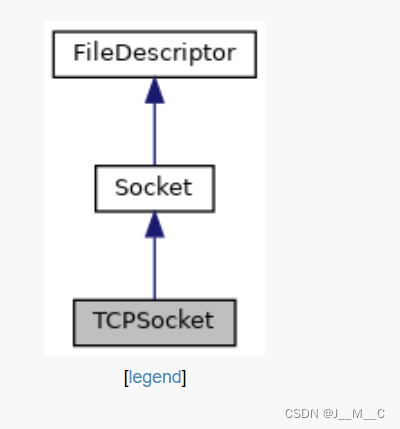
看一下接口,都是很常规的socket API,值得注意的一点是今年这里面有的API和往年的不一样!所以还是要以源码为准:

3.3 Writing webget
3.3.1 实现
终于要开始写代码了,在/apps/webget.cc里面写
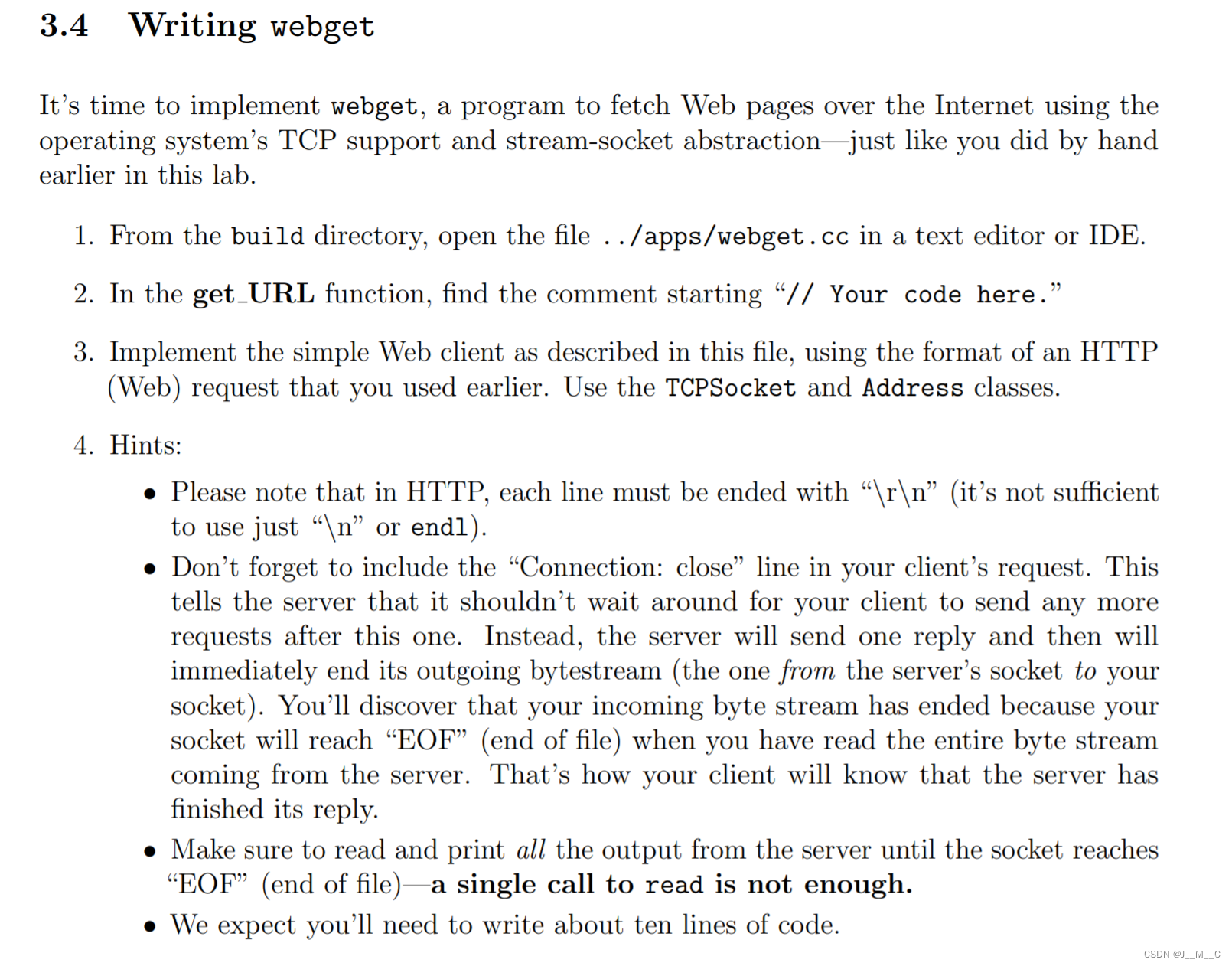
首先实现这个getURL,

其中注意发请求的时候要用\r\n,单纯\n是不够的,此外今年的FileDescriptor::read由直接返回读取的数据改成了传个string引用进去,我分析这么改的原因是为了与新的FileDescriptor::read( vector<unique_ptr<string>>& buffers )这个写入多值的函数形成API形式上的统一吧,不过这写着就丑陋一些了。
void get_URL( const string& host, const string& path )
{
TCPSocket sock;
sock.connect( Address( host, "http" ) );
sock.write("GET " + path + " HTTP/1.1\r\n" // 请求行
"Host: " + host + "\r\n" // 告知服务器主机名
"Connection: close\r\n" // 通知服务器关闭连接
"\r\n"); // 空行
sock.shutdown( SHUT_WR ); // 关闭写端
while ( !sock.eof() ) { // 读取所有数据
string tmp;
sock.read( tmp );
cout << tmp;
}
sock.close();
}
3.3.2 测试
我们在build文件夹下
make
./apps/webget cs144.keithw.org /hello
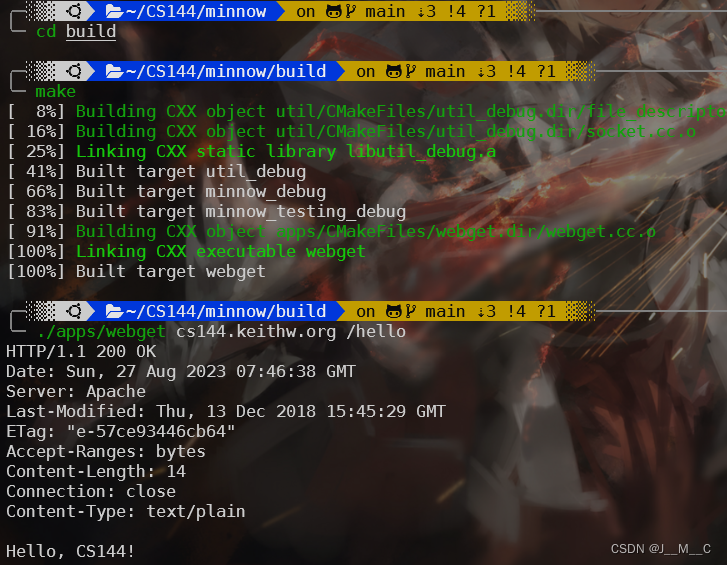
可以看到成功返回并打印了一些信息!
接着继续在build下面跑make check_webget测试一下,这一步我最早出现了很奇葩的问题:
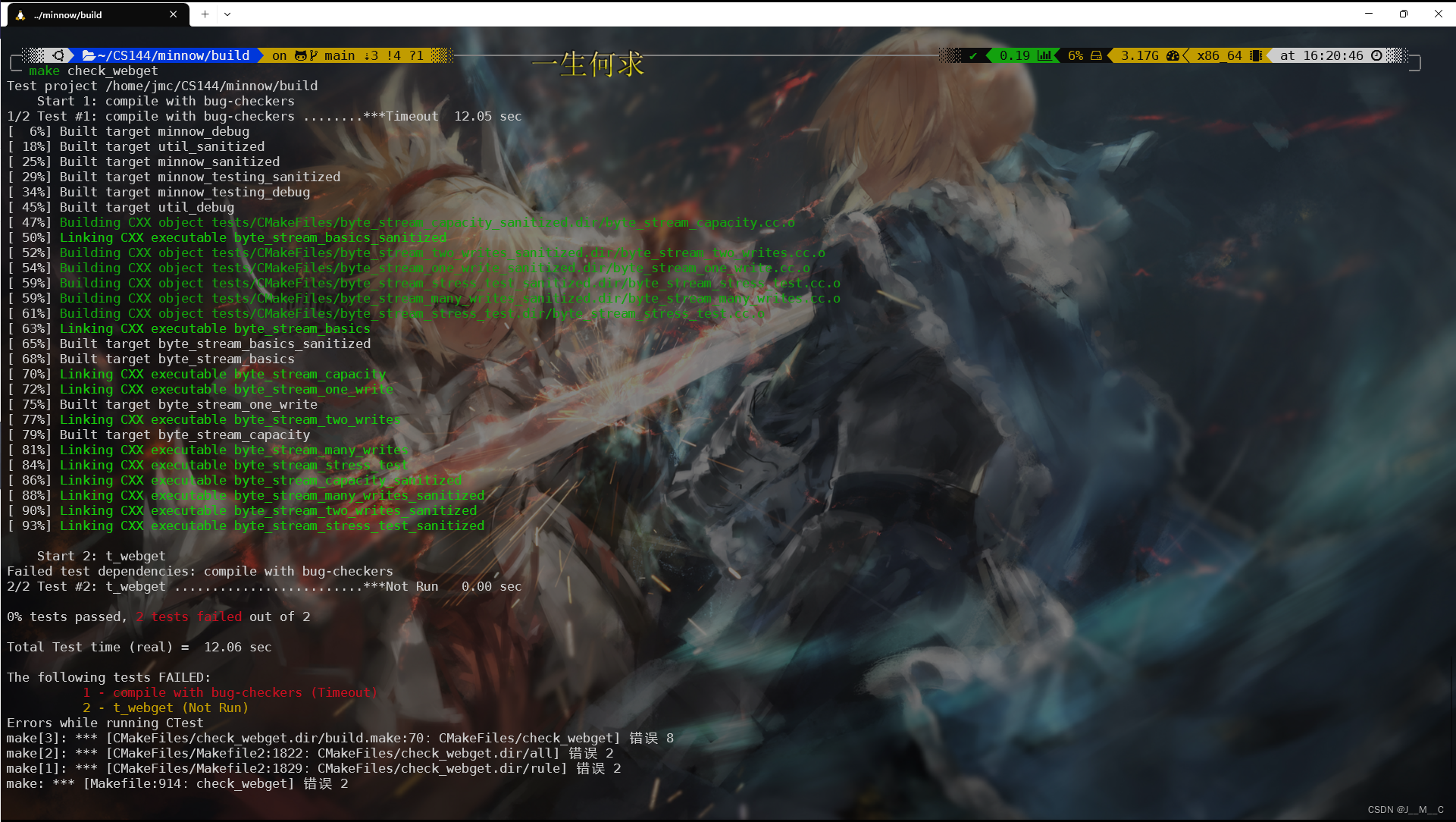
我把错误抠出来方便后来人搜索:
Test project /home/jmc/CS144/minnow/build
Start 1: compile with bug-checkers
1/2 Test #1: compile with bug-checkers ........***Timeout 12.05 sec
[ 6%] Built target minnow_debug
[ 18%] Built target util_sanitized
[ 25%] Built target minnow_sanitized
[ 29%] Built target minnow_testing_sanitized
[ 34%] Built target minnow_testing_debug
[ 45%] Built target util_debug
[ 47%] Building CXX object tests/CMakeFiles/byte_stream_capacity_sanitized.dir/byte_stream_capacity.cc.o
[ 50%] Linking CXX executable byte_stream_basics_sanitized
[ 52%] Building CXX object tests/CMakeFiles/byte_stream_two_writes_sanitized.dir/byte_stream_two_writes.cc.o
[ 54%] Building CXX object tests/CMakeFiles/byte_stream_one_write_sanitized.dir/byte_stream_one_write.cc.o
[ 59%] Building CXX object tests/CMakeFiles/byte_stream_stress_test_sanitized.dir/byte_stream_stress_test.cc.o
[ 59%] Building CXX object tests/CMakeFiles/byte_stream_many_writes_sanitized.dir/byte_stream_many_writes.cc.o
[ 61%] Building CXX object tests/CMakeFiles/byte_stream_stress_test.dir/byte_stream_stress_test.cc.o
[ 63%] Linking CXX executable byte_stream_basics
[ 65%] Built target byte_stream_basics_sanitized
[ 68%] Built target byte_stream_basics
[ 70%] Linking CXX executable byte_stream_capacity
[ 72%] Linking CXX executable byte_stream_one_write
[ 75%] Built target byte_stream_one_write
[ 77%] Linking CXX executable byte_stream_two_writes
[ 79%] Built target byte_stream_capacity
[ 81%] Linking CXX executable byte_stream_many_writes
[ 84%] Linking CXX executable byte_stream_stress_test
[ 86%] Linking CXX executable byte_stream_capacity_sanitized
[ 88%] Linking CXX executable byte_stream_many_writes_sanitized
[ 90%] Linking CXX executable byte_stream_two_writes_sanitized
[ 93%] Linking CXX executable byte_stream_stress_test_sanitized
Start 2: t_webget
Failed test dependencies: compile with bug-checkers
2/2 Test #2: t_webget .........................***Not Run 0.00 sec
0% tests passed, 2 tests failed out of 2
Total Test time (real) = 12.06 sec
The following tests FAILED:
1 - compile with bug-checkers (Timeout)
2 - t_webget (Not Run)
Errors while running CTest
make[3]: *** [CMakeFiles/check_webget.dir/build.make:70:CMakeFiles/check_webget] 错误 8
make[2]: *** [CMakeFiles/Makefile2:1822:CMakeFiles/check_webget.dir/all] 错误 2
make[1]: *** [CMakeFiles/Makefile2:1829:CMakeFiles/check_webget.dir/rule] 错误 2
make: *** [Makefile:914:check_webget] 错误 2
研究半天,这个应该是性能问题,虚拟机性能不好,所以跑半天超时了,解决方法是多跑几遍,或者直接去etc/tests.cmake下面把超时时间改多一点,后面的也是同理:
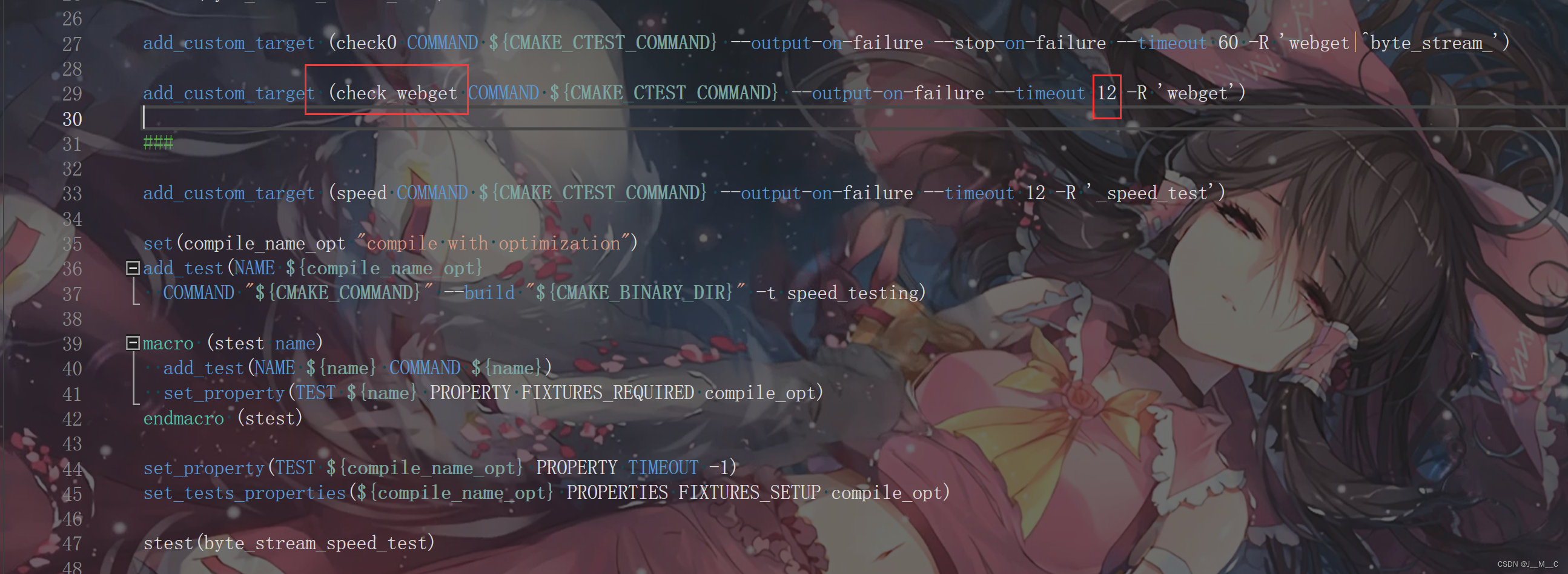
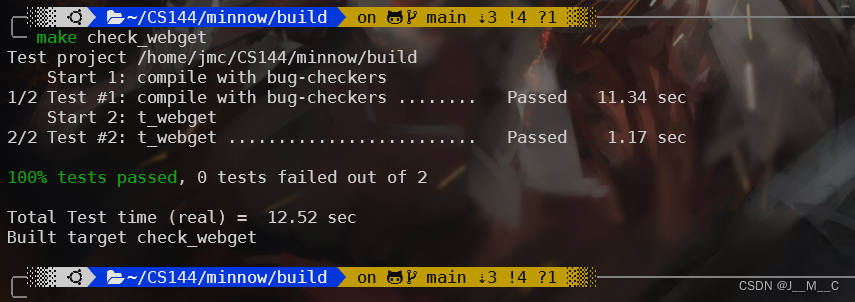
4. An in-memory reliable byte stream
4.1 思路分析
这个task就是叫我们抽象出一个数据结构,可以在一边读一边写,同时用一个capacity限制一下缓冲区的大小,这本质是一个队列的抽象。今年的这个task相比往年的再抽象了一层专用于读与写的子类,比较有意思。
我们先分析一下这个框架,很显然,我们的底层需要维护一个什么数据结构,然后还有几个显然是标志位的东西,我们直接维护一个flg然后置位即可。
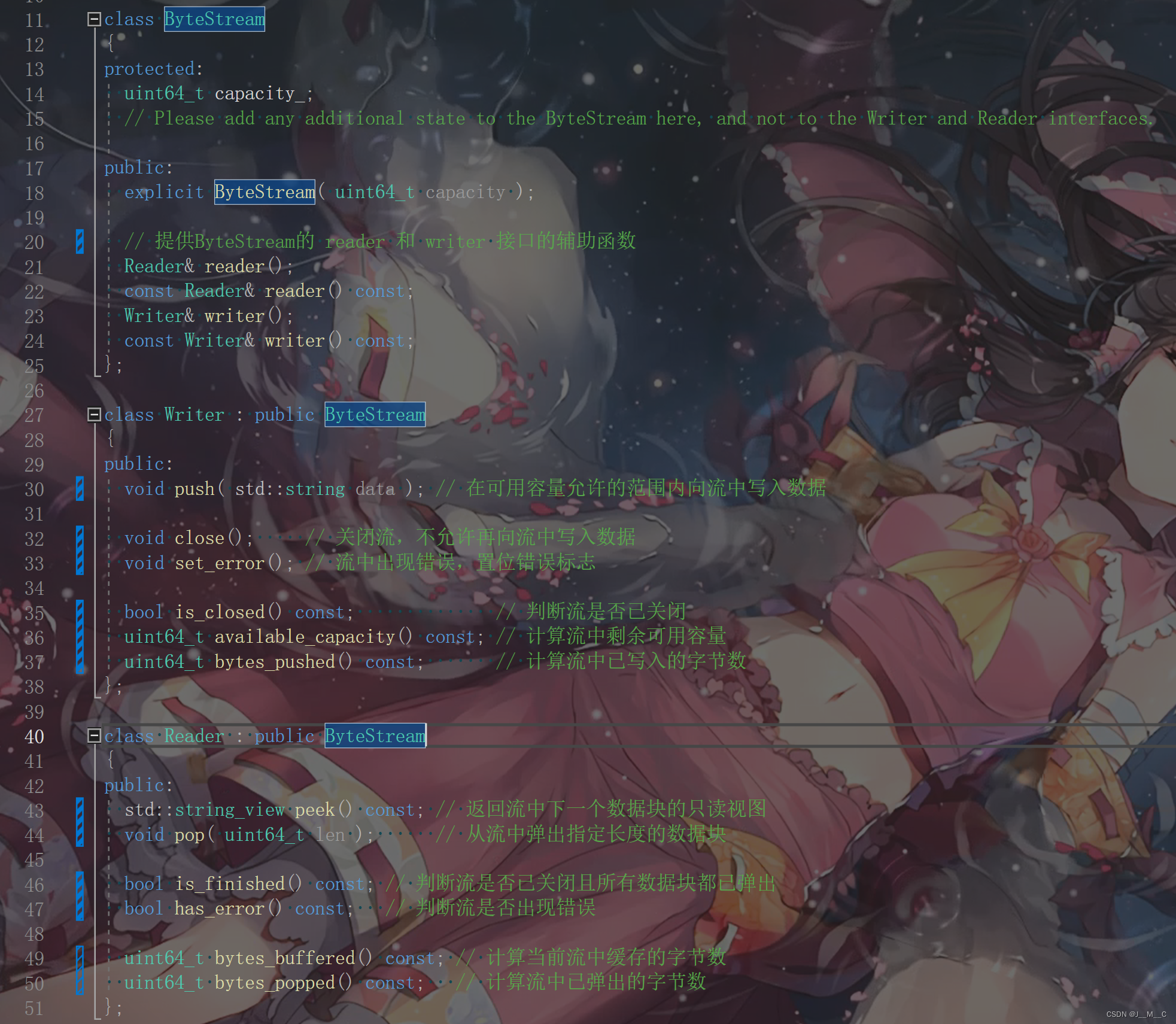
这个ByteStream的设计是有点类似于C++里基于流的IO的,和stringstream的功能差不多,都是实现基于char的流,不过bs和ss不同的是bs是FILO的,而ss是FIFO的,换言之我们的bs在这里像一个“滑动窗口”——-而且左右指针都始终向一个方向前进,这意味着如果我们像ss一样利用string这种简单的连续内存空间来维护我们的数据的话,将会造成左侧内存的浪费——写指针永远无法到达它以前到过的地方,因为它是单向运动的,此外它还无法实现完美转发,因为我们使用operator+=衔接串的话势必需要一次拷贝。
那么queue<char>如何呢?看起来它完美地实现了我们的需求:它是天然的FIFO数据结构,但是还是那个问题——它无法实现完美转发,我们在声明中就可以看到,push接受的参数是一个string值,而我们将string拆成char的这个过程势必涉及到拷贝,它是一个
O
(
n
)
O(n)
O(n)的操作——这甚至还没有考虑零碎空间造成的开销。
那如果考虑完美转发呢?push收到的是连续空间,我们就直接完美转发就行了。这意味着我们需要维护一片一片的连续内存,很容易想到,我们需要维护一个queue<string>,对于每个收到的字符串,我们直接转发进这个队列就行了,这样可以让我们的push操作本身达到
O
(
1
)
O(1)
O(1)时间复杂度,另外我们从测试程序可以看出,测试程序传给push的值本身就是个move来的右值,这意味着传参的过程也是
O
(
1
)
O(1)
O(1)的,因此实际上我们的这个操作时间复杂度就是
O
(
1
)
O(1)
O(1)。
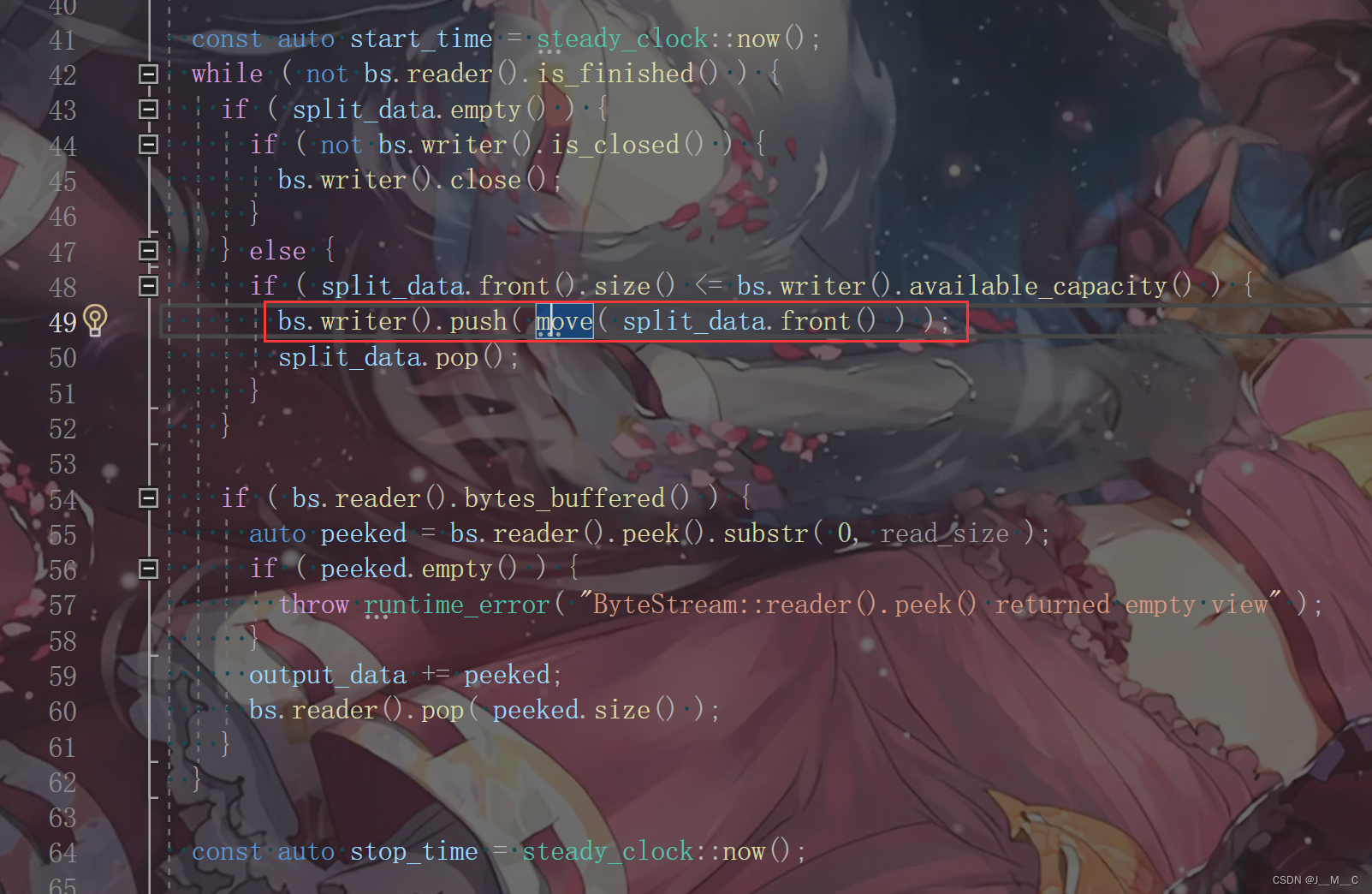
不过我们还需要考虑pop的实现,pop要求实现任意合法字符数量的弹出,一般思路是不断遍历并弹出队首,直到队首的长度不小于剩余需要遍历的数量的长度为止,然后用一个指针标记一下这个串这次遍历到的位置,下次就从这里开始遍历即可。因此我们需要维护队首字符串的起始位置,一种很优雅的实现是来自C++17的std::string_view,std::string_view实质上就是维护了连续字符内存上的两个指针。当然,我们也可以直接维护队首字符串的起始位置坐标,性能其实应该差距不大,这里就展示一下string_view吧。
4.2 代码展示
// byte_stream.hh
#pragma once
#include <queue>
#include <stdexcept>
#include <string>
#include <string_view>
class Reader;
class Writer;
class ByteStream
{
protected:
enum State { CLOSED, ERROR };
uint64_t capacity_;
uint64_t bytes_pushed_ {}; // 已写入的字节数
uint64_t bytes_popped_ {}; // 已弹出的字节数
unsigned char flag {}; // 0: normal, 1: closed, 2: error
std::queue<std::string> buffer_data {};
std::string_view buffer_view {};
public:
explicit ByteStream( uint64_t capacity );
// 提供ByteStream的 reader 和 writer 接口的辅助函数
Reader& reader();
const Reader& reader() const;
Writer& writer();
const Writer& writer() const;
};
class Writer : public ByteStream
{
public:
void push( std::string data ) noexcept; // 在可用容量允许的范围内向流中写入数据
void close() noexcept; // 关闭流,不允许再向流中写入数据
void set_error() noexcept; // 流中出现错误,置位错误标志
bool is_closed() const noexcept; // 判断流是否已关闭
uint64_t available_capacity() const noexcept; // 计算流中剩余可用容量
uint64_t bytes_pushed() const noexcept; // 计算流中已写入的字节数
};
class Reader : public ByteStream
{
public:
std::string_view peek() const noexcept; // 返回流中下一个数据块的只读视图
void pop( uint64_t len ) noexcept; // 从流中弹出指定长度的数据块
bool is_finished() const noexcept; // 判断流是否已关闭且所有数据块都已弹出
bool has_error() const noexcept; // 判断流是否出现错误
uint64_t bytes_buffered() const noexcept; // 计算当前流中剩余的字节数
uint64_t bytes_popped() const noexcept; // 计算流中已弹出的字节数
};
/*
* read: A (provided) helper function thats peeks and pops up to `len` bytes
* from a ByteStream Reader into a string;
*/
void read( Reader& reader, uint64_t len, std::string& out );
// byte_stream.cc
#include <stdexcept>
#include "byte_stream.hh"
using namespace std;
ByteStream::ByteStream( uint64_t capacity ) : capacity_( capacity ) {}
void Writer::push( string data ) noexcept
{
auto len = min( data.size(), available_capacity() ); // 确定可写入的数据长度
if ( len == 0 ) { // 如果可写入的数据长度为0,说明已经写满了,返回
return;
} else if ( len < data.size() ) { // 如果可写入的数据长度小于 data 的长度,说明只能写入部分数据
data.resize( len ); // 将 data 的长度截断为可写入的长度
}
// 将 data 写入到 buffer 中
buffer_data.push( move( data ) );
if ( buffer_data.size() == 1) // 写入前为空时需要更新 buffer_view
buffer_view = buffer_data.front();
// 更新已写入的数据长度
bytes_pushed_ += len;
}
void Writer::close() noexcept
{
flag |= ( 1 << CLOSED );
}
void Writer::set_error() noexcept
{
flag |= ( 1 << ERROR );
}
bool Writer::is_closed() const noexcept
{
return flag & ( 1 << CLOSED );
}
uint64_t Writer::available_capacity() const noexcept
{
return capacity_ - reader().bytes_buffered();
}
uint64_t Writer::bytes_pushed() const noexcept
{
return bytes_pushed_;
}
string_view Reader::peek() const noexcept
{
return buffer_view;
}
bool Reader::is_finished() const noexcept
{
return writer().is_closed() && ( bytes_buffered() == 0 );
}
bool Reader::has_error() const noexcept
{
return flag & ( 1 << ERROR );
}
void Reader::pop( uint64_t len ) noexcept
{
if ( len > bytes_buffered() ) {
return;
}
// 更新已弹出的数据长度
bytes_popped_ += len;
// 将 buffer 中的数据弹出
while ( len > 0 ) {
if ( len >= buffer_view.size() ) {
len -= buffer_view.size();
buffer_data.pop();
buffer_view = buffer_data.front(); // 最开始就保证了 buffer_data 不为空
} else {
buffer_view.remove_prefix( len );
len = 0;
}
}
}
uint64_t Reader::bytes_buffered() const noexcept
{
return writer().bytes_pushed() - bytes_popped();
}
uint64_t Reader::bytes_popped() const noexcept
{
return bytes_popped_;
}
4.3 代码测试
在build下运行make check0,可以看到我的电脑上跑了10.90Gbit/s的速度,这个是和电脑有关的,我的电脑比较拉,和运气也有关系,当然和算法关系更大。
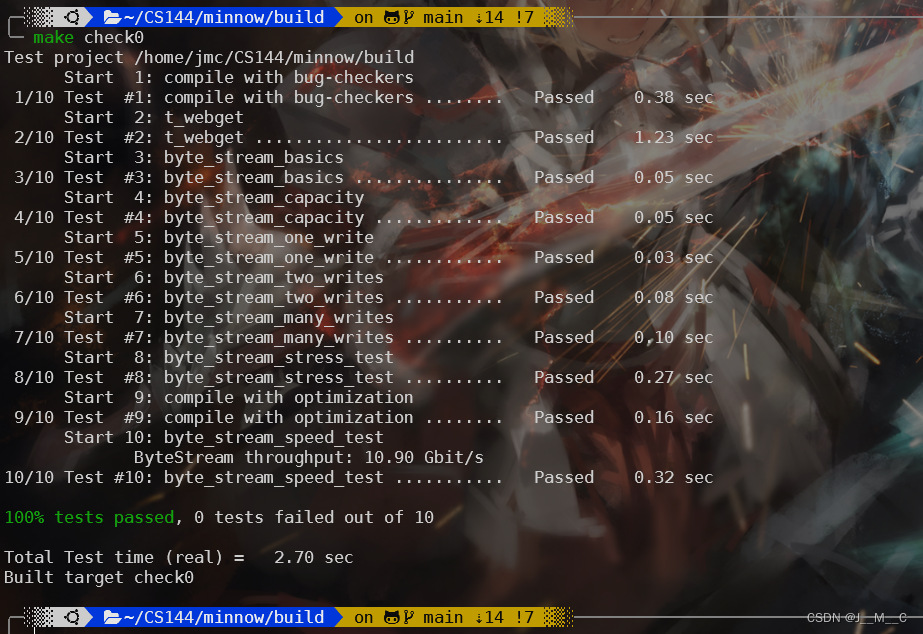





















 1341
1341











 被折叠的 条评论
为什么被折叠?
被折叠的 条评论
为什么被折叠?








